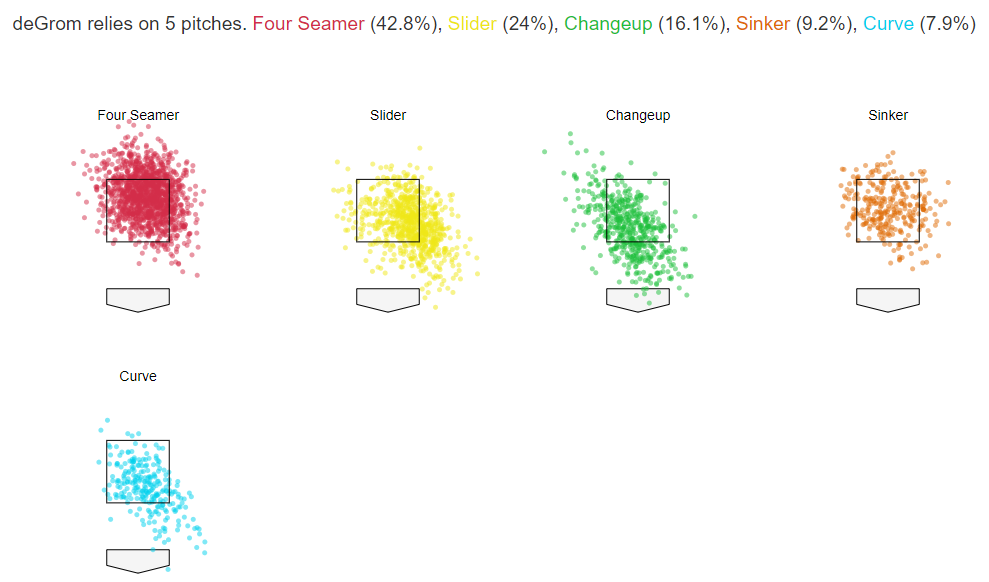
Jacob deGrom had a season for the ages in 2018.
Even Mets fans, who had grown accustomed to seeing his performances over the past few years, will agree that there was something extra out there last season. What transformed him from a solid ace into a dominant Cy Young award winner? Was there something he was doing differently in 2018 that got him to the next level? And if there was, can he repeat it moving forward?
I will attempt to answer those questions in this article.
The first thing I looked at when evaluating deGrom’s 2018 performance was his Quality of Pitch Average or QOPA. QOP looks at a combination of pitch speed, location, movement and quantifies the quality of a pitch. It has been shown to have a negative correlation with ERA (higher QOP = lower ERA). This would be a good place to start because if deGrom’s pitch quality was superior, it would ultimately be one piece of the puzzle explaining deGrom’s 2018 season.
Here is a chart I created on qopbaseball’s website which stacks deGrom’s pitch quality up against a few of the other top pitchers in the game:

qopabaseball.com
As you can see, deGrom’s overall pitch quality was 4.14 which was surprisingly below the major league average. Among all the pitches in his repertoire, the highest quality pitch was his two-seam fastball or sinker. This pitch had a QOPA of 4.69, which is above the MLB average. According to QOPA, this was one of his more effective pitches, but he only threw it a fraction of the time when compared to his four-seam fastball. If this was his highest quality pitch, why would he use it so infrequently? I wasn’t getting the answers I was looking for from QOPA so I kept looking.
The next thing I looked at was how often he used his pitches and how successful they were. Here’s a breakdown of how often he threw each pitch in 2018:

MLB Statcast
As you can see from the chart, there were two pitches that deGrom threw more often in 2018 than he did since 2015—his changeup and slider. While deGrom used his four-seamer as his primary pitch, his changeup and slider were used to keep hitters off balance and get them out. Two pitches that he threw less frequently in 2018 were his curveball and sinker.

MLB Statcast
DeGrom threw his slider 24 percent of the time in 2018, up two percent from 2017.
It wasn’t the increase in the frequency that made the difference as much as the improvement in spin rate and velocity. The harder it’s thrown and the tighter the spin on the slider, and the more it’s going to move and miss bats. And that’s exactly what deGrom did in 2018—his slider velocity increased almost 2 mph from 2017 and the spin rate increased from 2,453 to 2,496. These changes led to an increase in whiff% from 28.6 in 2017, to 36.1 percent in 2018!
Just as importantly, deGrom threw most of his sliders in a very good spot. As you can see from the heat chart above, most of his sliders were tailing away right-handed hitters and in on left-handed hitters. For a right-handed hitter, a pitch thrown like this would cause the batter to end up chasing pitches that start over the middle of the plate and then breaks late over the outside portion or even off the plate. Even if the hitter manages to get a bat on it, it would result in weak contact. It’s a similar outcome for the left-handed hitter who would end up getting jammed.
The pitch looks like it’s outside then breaks in over the inside portion of the plate. The left-handed hitter would have a better chance to barrel up a slider because it’s moving into his wheelhouse coming from a right-handed pitcher, which is why, I suppose, deGrom threw it more to right-handed batters in 2018. I should note that while deGrom through it less frequently to left-handed hitters in 2018, when he did throw it, it was used primarily when left-handed hitters were in a two-strike count.
![]()
I was also very surprised to see he threw more sliders to left-handed hitters in 2017, and a reversal in this trend alone could make a big difference in his ability to get hitters out at an increased rate in 2018.
Now let’s look at his changeup. Depending on who you ask, they may tell you that a good changeup is the hardest pitch to hit in baseball. I happen to be from that school of thought.
If you look at the heat map of deGrom’s changeup, you will see that he kept it low and inside to right-handed hitters. This is exactly where you would want to place this pitch, especially if it follows a four-seam fastball that was high and away—which, coincidentally is where most of his four-seamers ended up. This is also a very safe spot to throw the change against a left-handed hitter—left-handed hitters generally look for fastballs low and inside that they can drive—if you put a changeup down and outside on them, odds are they are going to be way out in front and not get good wood on the ball. This is probably why he used his changeup more frequently against LH hitters in 2018 (much more in 2018 compared to 2017).
DeGrom’s changeup went up in velocity by 2.3 mph in 2018 versus 2017. However, even though his velocity increased, his spin rate decreased. The decrease in spin rate would cause his changeup to have more downward movement and be more deceptive to hitters. This would cause the hitters to top the ball and hit weak grounders in the infield. These changes in 2018 led to an increase in Whiff% on his changeup by almost four percent. It was a very effective pitch in deGrom’s arsenal.
The improvement and increased frequency in his slider and changeup start to paint a picture as to how deGrom was able to transform from the solid ace of the Mets staff to one of the best pitchers in baseball. The effective use of these pitches led to career lows for deGrom in ERA (1.70), highest K% (32.2 percent), lowest Hard Hit % (32.2), WHIP (0.91), and second lowest BB% (5.5 percent).
While deGrom’s changeup contributed to his success, his slider was the difference maker in 2018. From improvements in his velocity, spin rate, and placement, to using it more against RH hitters and less against left-handed hitters, it was one of the key components to becoming one of the top pitchers in the game.
They say pitching is an art. If that’s the case, in 2018, deGrom used his slider to go straight from art school to the Louvre and earned himself a Cy Young Award. We can’t wait to see where he goes in 2019!















